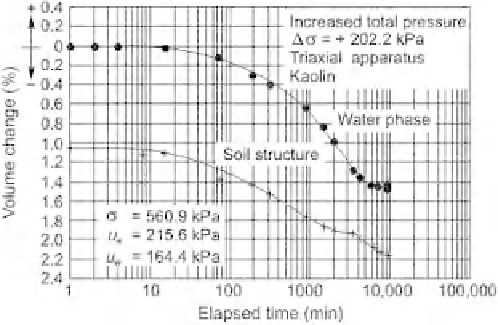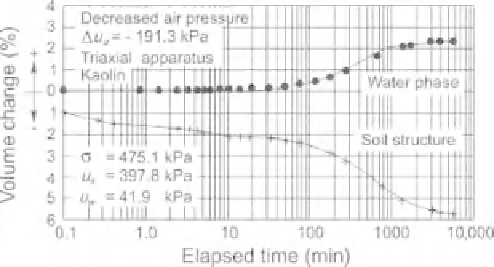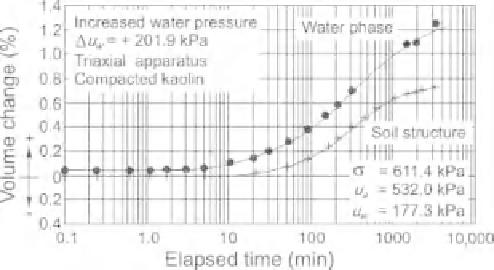Environmental Engineering Reference
In-Depth Information
Table 16.2 indicates that only test 1 was a consolidation
test in the classical sense that air and water flowed from the
soil specimen in response to an increase in the total stress.
Transient flow in other tests was caused by a change in
either the pore-air or pore-water pressures at the boundary.
The air and water flowed in a one-dimensional manner in
all tests. The one-dimensional consolidation theory could be
used to describe the transient flow of air and/or water during
each test.
Figure 16.4 shows a plot of volume changes resulting
from an increment of total stress for test 1. The plot shows
a decrease in the overall volume (i.e., the soil structure) as
well as the volume of air and water during the transient
process. A large instantaneous volume decrease occurred
when the load was applied.
An increase in the pore-air pressure in test 2 caused the
soil structure to expand temporarily (Fig. 16.5). However, the
increase in air pressure resulted in an increase in matric suc-
tion
u
a
−
Figure 16.6
Soil structure and water phase volume changes asso-
ciated with decrease in air pressure (test 3).
The volume change processes associated with a metastable-
structured soil are shown in Fig. 16.6. The decrease in air
pressure in test 3 reduced the matric suction and allowed more
water to flow into the specimen. The intake of water appears
to have reduced the normal and shear stresses between the soil
particles. As a result, the soil structure underwent a decrease
in volume (i.e., a collapse phenomenon).
An increase in water pressure (or a decrease in matric
suction) caused an increase in the overall volume in test 4.
Figure 16.7 shows that the soil has a stable structure and is
expansive. On the other hand, an increase in water pressures
(or a decrease in matric suction) causes the soil structure to
decrease in volume or collapse when the soil structure is
metastable (Fig. 16.8).
u
w
, which in turn caused a decrease in the volume
of the soil structure toward the end of the transient process.
16.4.3 Theoretical Analyses of Consolidation
Test Results
Attempts were made to best fit the theoretical analyses of
volume change with the results from laboratory experiments
(Fredlund and Rahardjo, 1986). Approximate coefficients of
volume change were selected for the soil structure, air, and
water phases based on the laboratory results. Table 16.3
summarizes the approximate coefficients of volume change
for each of the five specimens.
Figure 16.4
Soil structure and water phase volume changes asso-
ciated with increase in total stress (test 1).
Figure 16.5
Soil structure and water phase volume changes asso-
ciated with increase in air pressure (test 2).
Figure 16.7
Soil structure and water phase volume changes asso-
ciated with increase in water pressure (test 4).













Search WWH ::

Custom Search